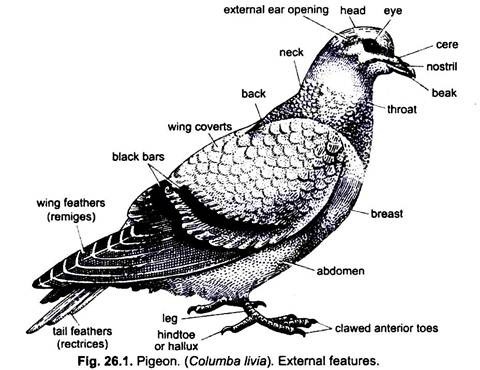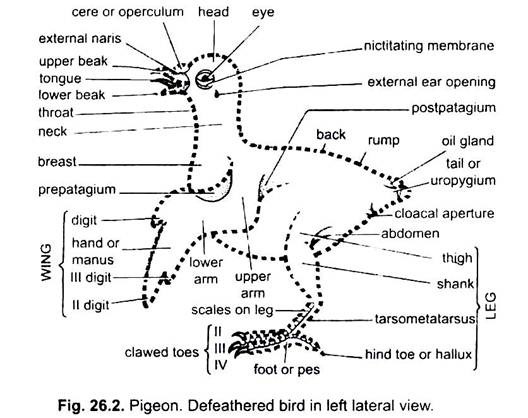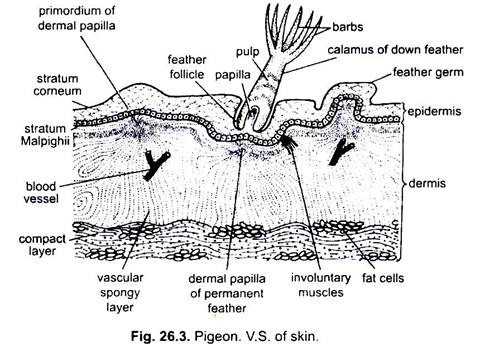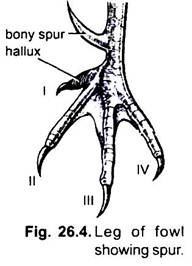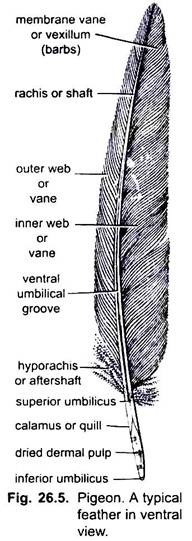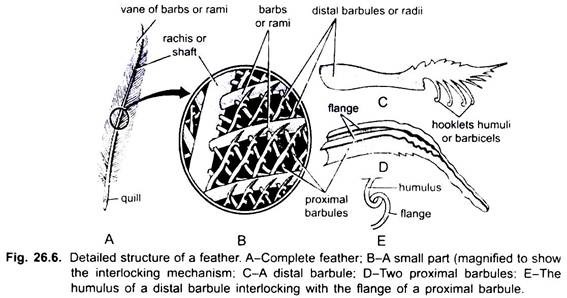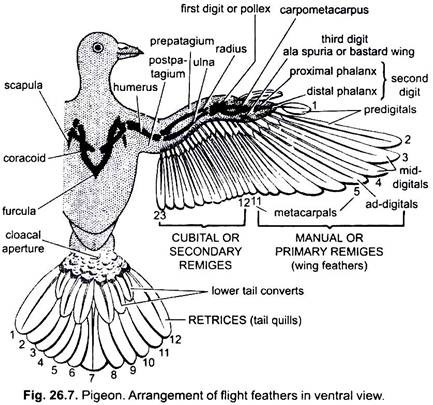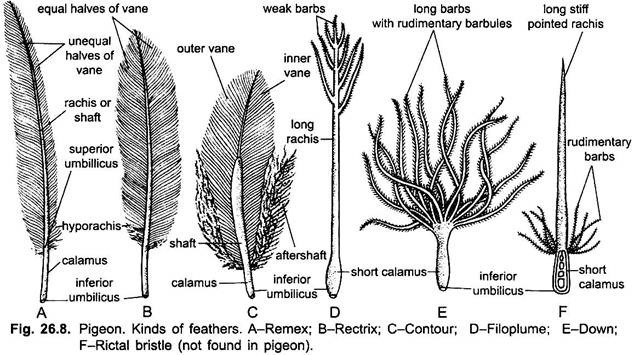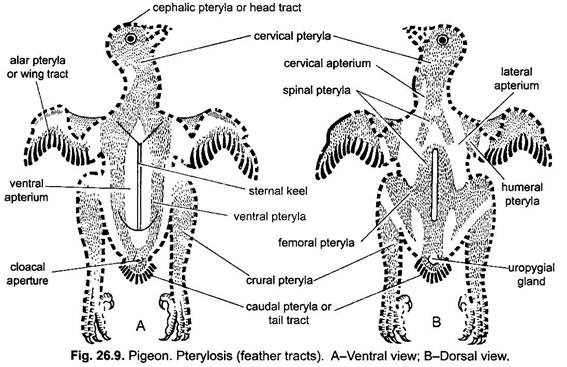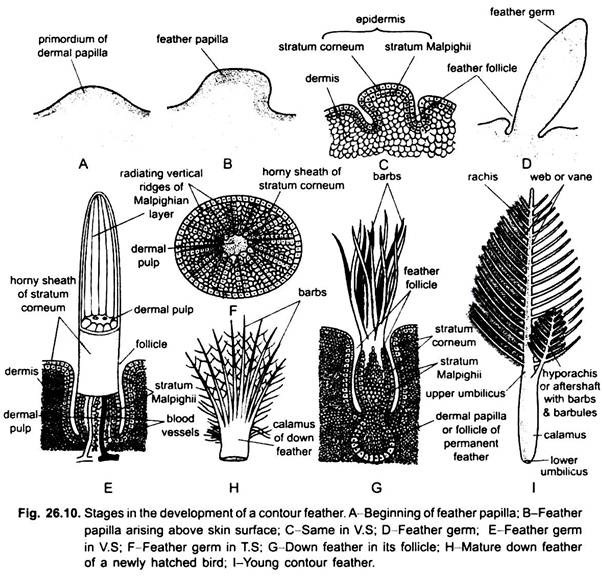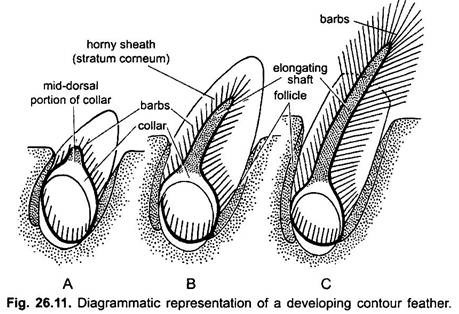In this article we will discuss about the external features of pigeon with the help of suitable diagrams.
Shape and Size:
The spindle-shaped or fusiform body of Blue Rock Pigeon is about 33 cm in length and is well adapted for rapid movement through the air.
Coloration:
Except the eyes and the feet which are pink, rest of the body of pigeon is a salty gray with glistening metallic green and purple sheen on the upper breast and around the neck. The wing has two black bars.
Body Divisions:
The bilaterally symmetrical and compactly set body of pigeon is divisible into four regions- head, neck, trunk and tail. All of these body divisions are invested in a close covering of feathers which are directed backward and overlapping one another.
ADVERTISEMENTS:
1. Head:
The head is small, rounded and mobile.
(i) Beak:
Head is prolonged in front into a short, pointed, bill or beak, which is formed by an elongated upper jaw and comparatively smaller lower jaw. Both jaws lack teeth and remain ensheathed by a horny sheath or rhamphotheca. The terminal mouth is thus guarded by horny beaks and forms a wide gape.
ADVERTISEMENTS:
(ii) Nostrils:
At the base of upper beak occurs a patch of naked, whitish, swollen area of soft skin, called operculum or cere. The cere overhangs on two oblique, slit-like external nares or nostrils which can be closed by the cere.
(iii) Eyes:
On either lateral side of the head is located a large eye. The eyes are round and are guarded by upper and lower eyelids and a transparent third eyelid or nictitating membrane. The nictitating membrane can be drawn across the eyeball from the anterior upper comer of the eye. The eyelids lack eyelashes and eyebrows,
ADVERTISEMENTS:
(iv) Ear apertures:
Below and behind each eye is an external ear opening which leads to a short tube, the external auditory meatus, closed by the tympanic membrane. These apertures are hidden under special auricular feathers.
2. Neck:
The neck is long, flexible and well demarcated from head and trunk. It helps in handling of food and compensates the forelimbs which have modified into wings.
3. Trunk:
The trunk is compact and spindle-shaped, bearing a prominent bony ridge, the keel or carina, at its mid-ventral line. There occurs a large, transversely elongated cloacal aperture on the ventral surface at the function of the uropygium (tail) with the trunk. The trunk bears two pairs of pentadactyl type limbs- one pair of wings and one pair of legs.
(i) Wings:
In pigeons, two forelimbs are modified into two powerful organs of flight, the wings. Each wing remains attached high on the antero-dorsal side of the trunk. Each wing is elongated, flattened and distally pointed with its longitudinal axis at right angles to that of the trunk. It can be folded close to the body in the form of Z during rest and extended during flight.
The wings show the three typical divisions of the forelimb- upper-arm or brachium, forearm or ante-brachium and the hand or manus, all closely bound together by skin. The manus or hand bears three, imperfectly-marked and clawless digits, of which the second is the largest.
On the anterior or pre-axial border of the limb a fold of skin stretches between the upper-arm and the forearm called the alar membrane or pre-patagium. A similar but much smaller fold extends, post-axially, between the proximal portion of the upper-arm and the trunk, called the post-patagium.
(ii) Legs:
The hindlimbs or legs arise somewhat anteriorly from the trunk to balance and support the entire weight of the body at rest. Each hindleg comprises three parts: the thigh, shank and foot. The thigh is short, closely bound to the trunk, and directed downwards and forwards. The shank is long and extends from the knee downwards and backwards.
The foot is clearly divisible into a proximal portion, the traso-metatarsus, and four digits. The digits are long and clawed. The first digit is called hallux and is directed backwards. The remaining three digits, the 2nd, 3rd and 4th, extend forward. The legs are efficient organs of perching and locomotion with long toes and curved claws.
4. Tail:
After removal of the feathers it can be seen that the true tail is short, conical projection of the trunk, known as uropygium. It bears a group of elongated tail-feathers or rectrices. On the dorsal surface of uropygium is a papilla bearing on its summit the opening of a preen, coccygeal, or oil-gland.
It is the only integumentary or cutaneous gland found in birds. Its oily secretion is used for lubricating or dressing the feathers and beak (makes them water-proof and shining). It produces a specific recognition scent and it elaborates ergosterol, which, when exposed on the feathers, is transformed by sunlight to vitamin D.
It is assumed that the vitamin would be ingested during preening. It is also probably used for keeping the horny beaks from becoming brittle. The tail with its feathers is used as a rudder during flight and a balancer in perching.
Skin:
The skin of pigeon is dry, loose, hard and thin. Histologically, it consists of an outer epidermis of ectodermal origin and an inner dermis of mesodermal origin.
(i) Epidermis:
The epidermis is several layers thick and composed of an outer epitrichium, a middle stratum corneum and an inner stratum germinativum or stratum Malpighii. The epitrichium is composed of a single row of flattened delicate cells. The stratum corneum is horny and protective and made of flat cornified cells.
It is modified to form several exoskeletal structures, such as the corneoscutes or scales on the feet, rhamphotheca or horny covering on the beaks, claws and toes and feathers which covers the most of the body. The stratum germinativum is made up of large, cylindrical and continuously dividing cells. It gives origin to the cells of epitrichium and stratum corneum.
(ii) Dermis:
The stratum germinativum of epidermis is followed by dermis. The dermis consists of muscle fibres, nerve fibres, blood capillaries, and connective tissue.
The epidermis and dermis have no pigmented cells, however, pigments occur in scales and feathers only. The skin lacks in sweat and any other type of cutaneous gland, except the uropygial or preen gland present dorsally at the base of tail.
Exoskeleton:
The pigeon has well developed exoskeletal system which serves many functions such as protection of body from temperature fluctuations of environment, radiations and mechanical injuries of various sorts. Further it makes the body of pigeon well adapted for aerial mode of life.
The exoskeleton of birds is derived from epidermis and occurs in the form of horny claws, beaks, spurs, webs, scales, feathers. Spurs are lacking in pigeons. Spur is a bony outgrowth of tarsometatarsus in the male fowl and some other birds. It is covered by a horny, scale-like epidermal sheath and pointed in shape.
Male fowl uses it for fighting. In certain birds (plover,etc.), spurs may be found on carp metacarpus. Webs are modified fold of skin found on the feet of aquatic birds, such as ducks, geese and swans. It is found stretched between the toes. In cormorants, it includes all the four toes. Sometimes it leaves the hallux free.
(i) Scales:
In pigeon, the scales are confined to the shanks and feet and some at the base of the beak. The scales are cornified derivatives of the stratum germinativum of epidermis which form a protective covering of body parts and are shed and replaced by moulting. The scales of pigeons and other birds resemble with reptilian scales in every respect, which indicates the origin of birds from reptiles.
(ii) Feathers:
The entire body of pigeon is covered with a close and continuous covering of feathers, which constitutes the plumage. The feathers are found only in birds and are modified reptilian scales.
They are light, strong, elastic, water proof and show many colours due to melanin pigment of various shades as well as due to iridescence. Melanins range from black through brown to yellow, and laid down in the feathers by special cells in the papilla. Carotenoid pigments are also found, such as the yellow zooxanthin, the red astaxanthin.
Structure of a Typical Feather in Pigeon:
To understand the structure of a feather, a contour feather which occurs on general body, wing and tail, can be considered as typical. A typical contour feather consists of a central axis, main stem or scapus and an expanded distal portion, the vexillum or vane.
1. Scapus (Axis):
The scapus is divided into a basal portion, the calamus and an upper shaft or rachis.
(a) Calamus:
The calamus is hollow, tubular and semitransparent. The base of calamus remains inserted into a pit or follicle of the skin, from which non-striated muscle fibres pass to the feather and provide movement to each contour feather. The calamus opens below by a small opening called inferior umbilicus, which receives a small, conical, nutritive dermal papilla from the dermis.
The nutrients and pigments are passed through the dermal papilla into the feather from the dermis, during the development of feather. Another pore, called superior umbilicus, occurs on the ventral side of junction of calamus and rachis.
In flightless birds like cassowary, emu and extinct Dinornis, the after shaft is as long as the main feather, from which it arises. In some pigeons and many other birds, a small tuft of soft down feather, called after shaft or hyporachis, occurs near the superior umbilicus and covers it.
(b) Rachis:
The part of the scapus above the calamus is a rachis. It forms the longitudinal axis of the vane. It is solid, opaque, roughly quadrangular in transverse section and filled with a closely packed mass of pith cells. A longitudinal furrow, the umbilical groove, runs along the ventral or inner surface of the rachis throughout its length.
2. Vane:
The rachis bears a fan-like, webbed or expanded membranous part of the feather, the vexillum or vane. The vane is divided by rachis into two unequal lateral halves. Its proximal end is broader than the distal end. Each half of vane is composed of a series of numerous (about 600), parallel, closely spaced, delicate, lateral, thread-like structures called the barbs or rami. The barbs arise obliquely outwards from the two lateral sides of the rachis.
The size of barbs gradually decreases towards both the ends of the rachis. Each barb on either side bears a fringe of small, extremely delicate, oblique filamentous processes, the radii or barbules. The barbules are of two types- proximal barbules directed towards the base of feather and distal barbules directed towards the tip of feather.
The lower edge of distal barbules bears minute, hamuli, barbicels or booklets and the upper edge proximal barbules are deeply curled or rolled to form a groove and flange. Hooklets of distal barbules hook over the grooved edges of proximal barbules binding the barbs together.
With this limited sliding interlocking arrangement, all the barbs and barbules are loosely held together, so that the vane forms a flexible, firm, wide, flat and continuous surface for striking the air during flight. This interlocking mechanism can be broken down so that the barbs become separate, but can be joined again by “preening” the whole feather.
The feathers of ostriches and kiwis lack this interlocking mechanism of feathers of pigeon. The barbs and barbules of after shaft have no hooklets or barbicels.
Feathers are always shed or moulted at regular intervals, as a rule annually after the breeding season. Some species of birds have a second lesser moult later on. During moult the old feathers drop out and new ones are formed from the same papillae. There is an elaborate hormonal control of the moult, basically by the thyroid.
Kinds of Feathers:
In pigeon, the feathers are variously modified to serve different functions.
They may be of following kinds:
1. Quill or Flight Feathers:
The quill feathers have a strong rachis or shaft having barbules with an interlocking arrangement.
They are classified into following types:
(i) Remiges:
The quill feathers occurring on the wings and serving the purpose of flight are called pinions, wing quills or remiges (singular, remex). In remiges the posterior half of the vane is slightly broader than the outer or anterior half. Each wing of pigeon has 23 remiges which remain attached to its hinder border.
Out of 23 remiges, eleven remiges are attached to the hand and are called primaries or manuals. The seven of these are attached to the metacarpal region and are called metacarpals. The remaining 4 are attached to the phalanxes of second and third digits and are called digitals which are further distinguished into- one ad-digital connected with the single phalanx of 3rd digit, 2 mid-digitals attached with the proximal phalanx of 2nd digit, and 2 pre-digitals with the distal phalanx of 2nd digit. The remaining 12 remiges are attached with the ulna of forearm and are called secondaries or cubitals. At the anterior border of the first digit (pollex) are attached a tuft of feathers called ala spuria or bastard wing.
(ii) Rectrices:
The quill feathers occurring around the uropygium to form the tail of pigeon are called tail-quills or rectrices. In pigeon, twelve long rectrices are arranged in semicircle or fan-like manner on the tail or uropygium. In rectrices two halves of the vanes are almost equal in size. The rectrices act as a brake in alighting and as a rudder in vertical or lateral steering.
(iii) Coverts:
The quill feathers covering the bases of wing quills and tail quills are called coverts. The bases of the wing-quills are covered by several rows of upper and under wing- coverts, and the bases of the tail quills by upper and under tail-coverts. They are of smaller size than the quill feathers but both are structurally similar. They close the interstices between the calamuses (quills) of remiges and rectrices and, thus, presenting a continuous area to oppose the buoyancy of the air.
(iv) Contours:
The quill feathers forming the general covering of the body are called contours or pennae. They are smaller and woolly feathers having poorly developed barbules due to which barbs can be easily separated. These provide warmth and the smooth air flow, without turbulence.
2. Filoplumes (Hair Feathers or Pin Feathers):
The filoplumes are small, delicate, hair-like feathers which remain sparsely distributed over the body among the contour feathers. A filoplume consists of a short calamus and a long thread-like rachis with a few weak terminal barbs, and barbules without any hamuli.
3. Down Feather or Plumule:
The down feathers are small, soft and woolly and lack the rachis but have a short calamus. The calamus bears a fluffy tuft of barbs which are long, flexible and with short barbules having no hamuli. In a young one, the down feathers cover the body and are called nestling down feathers. They have a horny sheath covering the quill and basal portions of barbs.
In adult pigeon, the nestling down feathers are replaced by contour feathers. But, they persist as an undercoat beneath the contour feathers in many aquatic birds, such as ducks and swans, serving to increase the thickness of the insulating layer.
Other Kinds of Feathers in Birds:
4. Powder-Down Feathers:
These are specialised type of feathers, well-developed in tracts or powder-down patches in herons, parrots and cockatoos, birds of prey, pigeons and especially frog mouths (Podargus). These feathers produce some powdery fragments for cleaning the plumage. The powder is a derivative of the innermost walls of Malpighian layer of the feather papilla.
5. Rictal Bristles:
Some birds, such as fly catchers, goat-suckers and whippoorwills, have stiff hair-like feathers called rictal bristles at the base of bill (rictus) and eyes. Each rictal bristle has a short calamus, and a slender rachis with a few rudimentary barbs at its base. They do not occur in pigeons.
6. Other Types:
There are certain other kinds of feathers which do not occur in pigeons, but occur in different birds. For example, tactile feathers or vibrissae occur at the root of the beaks or round the eyes of nocturnal birds, such as owl. Other peculiar feathers, such as bristles at the gape of Night jars, eyelashes of Hornbills, wires of birds of paradise and ornamental plumes of many birds, are modified contour feathers.
Pterylosis:
The arrangement or distribution of feathers on the body is called pterylosis. In pigeons and majority of birds, except penguins, the feathers are not uniformly distributed over the whole body but are arranged in distinct patches or tracts called pterylae.
The pterylae are followed by featherless areas or apteria which are covered with filoplumes in pigeons and by down feathers in ducks and many other birds. In flightless birds apteria are usually found only in the young, the adult having a uniform covering of feathers.
The principal feather tracts or pterylae of pigeon are following:
(i) Head or cephalic. Covering the head.
(ii) Neck or cervical. On the neck.
(iii) Shoulder or humeral. Across the upper arm or humerus,
(iv) Spinal. Extending from neck to tail along the vertebral column,
(v) Ventral. It is a double tract with one branch running along each side of the breast.
(vi) Wing or alar. Composed of remiges with their coverts.
(vii) Tail or caudal. Composed of rectrices with their coverts.
(viii) Femoral or lumbar. Spreading obliquely on the outer side of the thigh,
(ix) Crural. Covering the shank of leg.
Development of Feathers:
Feathers, like scales, arise in the embryo from papillae of the skin formed of dermis with an epidermal covering. The down feathers and contour feathers have different types of development, therefore, should be discussed separately as under.
(a) Development of a Down Feather:
The mesodermal tissue of the dermis of delicate and semi-transparent skin of five-or six- day old embryo gather at a place to form a dermal papilla externally covered by epidermis. As the dermal papilla grows it takes the shape of a cone whose apex is directed backward.
The papilla then becomes sunk in a sac called the feather follicle, from which it protrudes as an elongated feather germ. Its vascular dermal interior having the dermal blood capillaries, nerves and connective tissues is called feather pulp. The feather pulp feeds the growing feather.
The Malpighian layer of distal part of feather germ proliferates in such a way as to form a series of vertical or longitudinal radiating thickenings or ridges, which later separate from one another converting into the rami or barbs.
The Malpighian layer of the epidermis at the base of the feather germ becomes horny or cornified to form calamus. The stratum corneum of the epidermis forms a horny, transparent and coherent cylindrical sheath, called periderm around the growing feather.
As the feather the feather germ is resorbed, the periderm almost parallel to one another and slightly calamus. On the barbs, the barbules develop the calamus to form pith. Thus, a rudiment papilla persists at the base of the feather, to down feather during ecdysis.
(b) Development of a Contour Feather:
In the development of contour feather, the feather papilla is formed from the lower or deep end of that of the down feather, so that the earlier down feather drops off from its apex. Its early development is the same as in down feather.
After the feather germ with its feather pulp, longitudinal ridges are not of the same size. Instead, two mid-dorsal Malpighian ridges thicken and fuse together to form a solid rachis which elongates and grows outwards more rapidly than the rest due to differential growth. As the rachis elongates, it carries up with it the remaining ridges which become the lateral barbs. New barbs appear below. A similar fusion of two ventral barbs with differential growth results in the formation of hyporachis or aftershaft.
Later barbules arise from both sides of the barb. The periderm splits and dries, the developing feather splits along the mid-ventral line and the barbs flatten out to form the vane. The portion of shaft which remains in the skin becomes calamus. The original basal aperture of feather germ becomes inferior umbilicus. The superior umbilicus develops later. The feather pulp inside the calamus dries to form the partition like pith.
Moulting or Ecdysis:
Shedding and replacement of feathers is moulting or ecdysis which takes place gradually, one moulting usually takes an average time of six weeks. At the base of each feather follicle, a dermal papilla persists from which new feathers will form. Thus, there is a continuous replacement of feathers throughout life. The replacement of feathers is seasonal in some birds such as peacock, while in other birds such as pigeon it is gradual throughout the year.
Pigmentation of Feathers:
The characteristic pigmentation or colouration of pigeon’s body is due to pigments in feathers and also due to characteristic arrangement of feathers. The feathers of pigeon and other birds show a varied and often brilliant colourations. The colours are produced partly by pigments and partly by reflection and diffraction effects (structural colouration).
The most common pigments are melanins, ranging from black through brown to yellow.
The colours are due to three factors:
(a) Pigment is deposited in the feathers during development by special cells in the papilla. The processes of these amoeboid chromatophores convey granules of pigment into the barbs and barbules, where they are laid down in layers between those of keratin. Carotenoid pigments are also found such as the yellow zooxanthin and red astaxanthin.
The colour that is seen, is due to absorption of some wavelengths of light by the pigment, thus, black, red, brown, yellow and orange colours are seen. White colour is not due to white pigment but is caused due to reflection of light from the feather without absorption of any wavelengths of light rays. In blue colours incident light is reflected from a layer of spongy keratin, pierced by holes 1-2 µm in diameter which absorbs the red and reflects blue light.
(b) Structural arrangement or striations of feather surface are prismatic; these cause iridescence due to reflection of light, thus, producing iridescent hues metallic colours, gray and some shades of blue. In iridescent feathers interference of light in thin surface films gives colours like those of soap bubbles.
(c) A combination of pigments and prismatic striations of the feather produces green in which the yellow pigment combines with the structural blue. The colouration of birds are for concealment, recognition, and sexual stimulation and, hence, as the basis of their social life.
The actual colour patterns vary with the habits of the bird. Concealing (cryptic) colouration is very common. Even the bright colours may serve this purpose, by breaking up the outline of the bird when at rest or in motion. Most birds are dark above and pale below. The feathers often show mottled or speckled patterns rather than homogeneous colour.
Finches and other birds living in sunlit upper branches show bright yellow, yellow-green, and blue colours, either singly or combined. Birds like thrush and blackbird living in thickets are usually dull brown or black. In most species colouration is a compromise between concealment and display, female is cryptic, the male conspicuous {e.g., ducks). Some colour pattern may be a warning of distasteful quality, e.g., magpie colour pattern of black and white.
Uses of Feathers:
The feathers are unique structures which are found only in birds.
They serve a varied array of functions which have been summarised below:
1. Protection:
Feathers form a lightweight, impervious, flexible, durable and waterproof body covering. They protect the underlying tender skin from all kinds of mechanical, chemical, pathological and environmental injuries.
2. Heat Retention:
The birds have a constant body temperature which commonly remains in between 104° and 112°F, even in subzero weather. Thus, the feathers serve the most important function of retention of heat because the plumage forms an efficient, non-conducting covering with its innumerable dead air spaces, useful as insulation. In cold weather the heat loss is reduced to minimum by fluffing out the feathers, which increases the depth of insulating material by adding to the air spaces within the feathery layers. In warm weather, the feathers are often held close to the body to allow some escape of body heat.
3. Flight Adaptation:
Feathers make the bird’s body well adapted for aerial mode of life. They are light, elastic, horny structures which make the body of birds of quite light weights. Further, the thin, flat and overlapping wing and tail feathers, with their close almost airtight linkage due to the interlocking arrangement of barbules, form surfaces to support the bird in flight.
4. Camouflaging (Protective Colouration):
The feathers of different birds have quite characteristic protective colouration like the colouration of their surroundings, which make them indistinguishable from their habitual surroundings and, thus, serve to protect them from their enemies.
5. Sexual Dimorphism:
Feathers provide protective colouration and also sexual display. Sexual dimorphism is common in monogamous as well as polygamous species. Colours and erectile plumes become sign stimuli which evoke or release specific reactions and whole pattern of behaviour in rivals and mates.
Ornaments like bars and spots on the wings and tail, fully exposed only during flight in many gregarious birds, and often widely different in closely allied species, are probably recognition marks which enable stragglers to distinguish between a flock of their own and other species.
For example, on many birds the crown feathers are modified into crests (peacock), topknots (tufted titmouse), ornamental plumes (California quail), etc. Some birds have special ruffs (ruffed grouse) or pinnae (prairie chicken) about the neck. Breeding plumes (cigrettes) in certain herons and egrets, upper tail, coverts in peacocks and elongated decoration in the streamers of some birds of paradise, serve the similar secondary sexual function.
6. Formation of Nest:
Some birds such as eider-duck and long-tailed-tit, use the feathers of other birds in the formation of warm and comfortable nests for their nestlings.
7. Other Uses:
The powdery secretions of powdery down feathers of many birds (e.g., herons, bitterns etc.) help in keeping the plumage clean and free from ectoparasites. The feathers also provide a characteristic individuality to each species of bird, thus, have significant role in speciation. The spine-tipped rectrices of chimney-swifts and woodpeckers help them in clinging to vertical surfaces. Markings on feathers are recognition marks to their fellow birds.
Feathers are used for stuffing cushions and mattresses. In some birds patches of special feathers without a rachis break up to make a greasy “powder down”.
